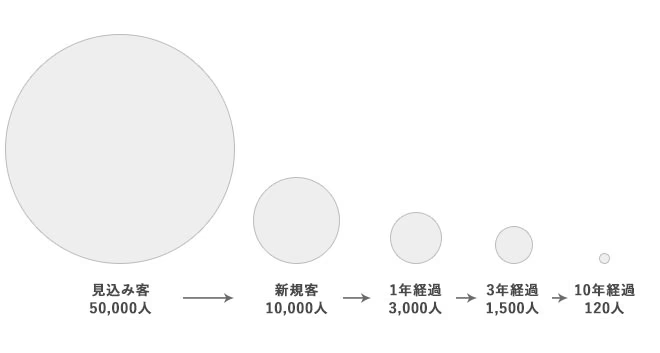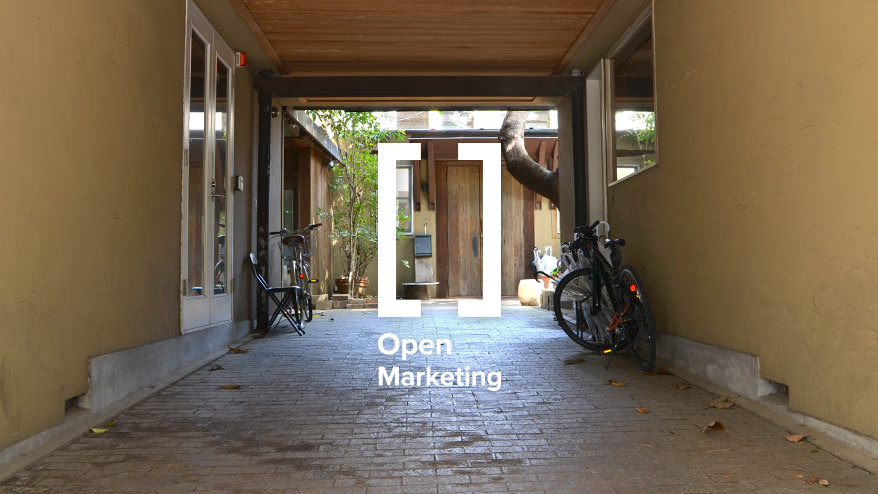みなさん、こんにちは。モノサス代表の林です。
これまで4回にわたってOpen marketingの考え方についてお話してきましたが、
今回は、数値的な面から既存のマーケティングのあり方の問題点を
考えていきたいと思います。
新規顧客を集め続けないといけない
という強迫観念
私がマーケティングの現場でいつも感じるのは
常に「新規客を集め続けないと、会社が存続しない」という
強迫観念にも似たものを、多くのマーケッターが持っていることです。
もちろん新規客の集客を、やめてよいなどとはまったく思いません。
しかし、バランスが大きく偏っているように感じるのです。
マーケティングの会議の重要な議題のトップは
いつも新規客の獲得をどうするかです。
また、既存客に焦点のあたった打ち合わせをしていても、
それは「既存客にどうやってもらったら買ってもらえるか」ということです。
しかし、「どうやったら買ってもらえるか」などと考えないといけないうちは
その顧客は“既存客”ではあっても、本当の意味での“固定客”ではありません。
ただ自社の商品・サービスを買ったことがあって、
広告費をさほどかけなくてもアプローチすることができる
一群の名簿にしかすぎないのです。
本当の固定客とは、
「あなたの会社・商品がなくなったら、困る」
と思い、こちらが買ってほしいと押し売りをしなくても
買いつづけてくれる顧客のことです。
わたしはこういう顧客は、
会社に利益をもたらす顧客というよりは、
顧客側も会社の商品・サービスによって利益を得ている、
つまりは価値を交換しあっている関係だと思っています。
すべての顧客とこういう関係を築くことは
ほぼ不可能だと思いますが、
こういう顧客の割合を増やそうということに
多くの企業が、あまりに無頓着なのではないかと思うのです。
「とにかくこの商品をつくりつづけてほしい」
少しこのことについて具体的なお話をしてみたいと思います。
3年ほど前に手がけた、とある女性向けのヘアケア製品を製造・販売している
会社でのプロジェクトでのことです。
当初いただいたご相談は、やはり、いかに新規客を集めるかということと、
既存顧客からの購買比率を引き上げることでした。
現状どのようなマーケティングをしているかを伺ってみると、
メインの販売チャネルである自社通販の新規顧客の獲得と
既存顧客向けの再購入促進用のDMにマーケティング予算の大部分を
割いていました。
中でも特に新規顧客の獲得には非常に苦労されていました。
通販に取り組んだ経験のある方ならよくわかると思いますが、
新規客を集めるために、サンプルの配布や、お試し商品の割引販売などを
しながら、そこからの定着化に問題を抱えていました。
一方で、いろいろとお話を聞いていると、この会社のヘアケア商品は、
非常に商品力が高いものであることがわかってきました。
私は試しに「10年以上買いつづけてくださっているお客さまはどれくらいいますか?」と
聞いてみました。
そうすると担当の方から帰ってきたのは、驚くような数字でした。
(この先ご紹介する数字は、企業の具体的な業績に関わる内容ですので、
桁数や内容を変えてご紹介します)
少なかったのではなく、とても多かったのです。
しかし、会社全体の業績を支えるほどの数ではなく、
過去1年に購買履歴のある既存顧客の中の1割にも満たない数字ではありました。
しかし、考えてもみてください。
1社のヘアケア製品、つまりシャンプーやリンス、トリートメントといったものを
10年以上にわたって使い続けることは、消費者の購買行動としては
明らかに異常です。
そんな顧客が100人や1,000人ではなく、10,000人以上の単位で存在していることに
私たちは注目をしました。
そこで私たちは、そういう顧客(以後固定客)が、なぜ10年以上にわたって
使いつづけてくださっているのかを、インタビューしてみることにしました。
いろんな気づきがあった中で、今回のテーマとも非常に深く関わる
発言が何度もありました。
それは、
「わたしたち(ヘアケア製品会社)になにか望むことはありますか?」
という質問をしたところ、ほとんどの方が
「特にない・・・」と答えたあとに、
「なにも不満はないのですが、要望があるとすれば、
とにかくいまのこの商品をつくりつづけてほしい」
とおっしゃったのです。
このインタビューから見えた固定客の特徴をピックアップしてみると、
以下のようなものです。
- 製品開発時に目指した狙いに、ぴたりとはまる悩みを持っている
- その悩みを製品によって解決され、その自覚がある
- 製品を使い続けることが習慣化され、使えないような状況が訪れるとストレスを感じる
- その製品を提供している会社を擬人化し、人間的信頼を感じている
- 明確な継続購買意思がある
製品開発時に目指した狙いに、ぴたりとはまる悩みを持っている
その悩みを製品によって解決され、その自覚がある
製品を使い続けることが習慣化され、使えないような状況が訪れるとストレスを感じる
その製品を提供している会社を擬人化し、人間的信頼を感じている
明確な継続購買意思がある
私はこれらをまとめてみて、確信しました。
固定客を集めることに、マーケティングの力を集約すべきだと。
新規客を集めつづけないと、
ビジネスがつづけられない構造
ここで少し、固定客化することの意味を具体的な数字でみてみたいと思います。
さきほどヘアケア製品の事例をご紹介しましたので、近しい業態から、美容系の通販で
考えてみたいと思います。(さきほどの企業の数字とは無関係です)
話を単純化するためにかなりデフォルメしていますので、
そのままみなさんのビジネスにあてはまらない部分はあるかと思いますが、
ブリッジングしながらお読みいただけると幸いです。

顧客獲得フローイメージ
美容系の通販などでは、いきなり新規客を獲得することは少なく、
多くの場合、サンプルの配布や、低価格でのお試し商品を販売することが多く、
これが見込み客にあたります。
そして、この企業が仮に新規顧客を年に10,000人集めたいとします。
お試し購入の見込み客から、実際に商品を購入してもらえる率を20%程度とすると、
年間に50,000人の見込み客を集めなければなりません。
(多くの場合はこれよりも低くなる場合が多く、30%を超えるような場合は稀です。
一部、お試し購入の価格をあらかじめ高く設定し、ハードルを上げているような場合は
この限りではありません)
実際に商品を購入してくれたとしても、2年目も商品を購入してくれる人は、
大体30%程度です。
そして、2年目に購入してくれた顧客は3年目以降は大体70%程度は残留する傾向があります。
そうすると、3年経過後に約1,500人、10年経過後には約150人が固定客化として残っていることになります。
サービス系のサイトであれば、見込み客から新規客への移行率は高くなりますが、
その分見込み客の獲得件数は少なくなる傾向にあるなど、
業種・業態によって多少状況は異なりますが、ここで大事なのは、
最終的に固定客にたどり着く割合が非常に少ないことです。
実は、もうひとつ大切なことがあります。
このペースでビジネスをずっと継続した場合、顧客数が途中からほぼ伸びなくなるのです。
少々乱暴な設定ですが、1年目から10年目まで、新規客10,000人、2年目定着率30%、
3年目以降定着率70%でビジネスを続けると、10年間の顧客数の推移は下記の表のようになります。
(ここでいう顧客数とは、その年に1度でも購買をしたことがある顧客の数とします)
| 年度 | 顧客数 | 3年以上継続客数 |
| 1年目 | 10,000人 | 0人 |
| 2年目 | 13,000人 | 0人 |
| 3年目 | 15,100人 | 0人 |
| 4年目 | 16,570人 | 1,470人 |
| 5年目 | 17,599人 | 2,499人 |
| 6年目 | 18,319人 | 3,219人 |
| 7年目 | 18,824人 | 3,724人 |
| 8年目 | 19,176人 | 4,076人 |
| 9年目 | 19,424人 | 4,324人 |
| 10年目 | 19,596人 | 4,496人 |
5年目までは順調に顧客数が増えるのですが、
6年目以降成長が鈍化し、以降ほとんど伸びていきません。
また、固定客の目安となる3年以上継続購入してくださっている顧客の数も
8年目あたりまでは順調に増えるのですが、以降は伸びが鈍化し、
ほとんど増えなくなっていきます。
業種・業態によって変化のある数字ですが、
おおまかに顧客を構造化すると、多かれ少なかれ、
このような構造になっていることが多いのではないでしょうか。
ではこの構造が抱える問題はなんでしょうか。
新規客の獲得が減ると顧客数が大幅に減る
これは10年目の数字を見るとよくわかります。
新規顧客の獲得数は10,000人であるにも関わらず、顧客の総数は19,596人です。
つまり総顧客の約半分がその年に集めた新規客だということです。
客数と売上は比例しますので、売上の多くの部分を、膨大な獲得コストのかかる
新規顧客に頼ってしまう構造になっているのです。
6〜7年目までで収益化ができていないと、ビジネスモデルの見直しを迫られる
6年目で顧客数の増加が鈍化し、7年目で固定客の増加が鈍化しますので、
その時点で収益化していなければ、企業の粗利構造自体が破綻していることになります。
新規客獲得コストは多くの場合、年々悪化するもの
新規顧客の獲得コストは、当初の数年はどんどん改善しますが、
それをすぎるとほぼ悪化していく傾向にあります。
つまり、収益構造がだんだん悪くなっていくということです。
この状態を改善するための手段として常に会議の議題になるのが、
「新規顧客の獲得を増やす」ことなのです。
ある意味正しい理屈ではありますが、実際にマーケティング担当者や
経営者の気持ちはこのようなものだと思います。
「恐くて、新規客獲得に向ける手を止められない」
売上の大部分を占める新規客の獲得は、膨大なコストがかかるとわかっていても
売上を落とすことが恐くて、力が抜けないのです。
つまりは、新規客を集めつづけないとビジネスをつづけられない構造に
なってしまっているのです。
しかし、さきほども触れたように、5年も同じものを売っていると、
ほぼ確実に新規客獲得のコスト効率は悪化していきます。
市場における目新しさの欠如や、競合からの圧力、市場自体の飽和など
原因はいろいろと考えられます。
そこで新たな新規顧客を獲得するために、新たな商品を売り始めたりするのです。
しかし、もう一度さきほどの顧客数の推移を見る軸を増やして、見てみたいと思います。
| 年度 | 顧客数 | 3年以上継続客数 | 5年以上継続客数 |
| 1年目 | 10,000人 | 0人 | 0人 |
| 2年目 | 13,000人 | 0人 | 0人 |
| 3年目 | 15,100人 | 0人 | 0人 |
| 4年目 | 16,570人 | 1,470人 | 0人 |
| 5年目 | 17,599人 | 2,499人 | 0人 |
| 6年目 | 18,319人 | 3,219人 | 720人 |
| 7年目 | 18,824人 | 3,724人 | 1,225人 |
| 8年目 | 19,176人 | 4,076人 | 1,577人 |
| 9年目 | 19,424人 | 4,324人 | 1,825人 |
| 10年目 | 19,596人 | 4,496人 | 1,997人 |
今回は5年以上継続客数も加えてみました。
表の赤の網掛け部分をご覧いただくと見えてくるのですが、
実は10年目には約10%が5年以上継続客存在しています。
伸び悩んでいるとはいえ、3年以上継続客の割合も約23%あります。
では、5年以上継続客の割合が2倍だったらどうでしょうか。
そしてもしも3倍だったら・・・。
計算するまでもなく、業績は大幅に改善します。
しかし、同じビジネス構造のままではこれを実現することはほぼ不可能です。
Open Marketingはこの構造への疑問を投げかける考え方でもあります。
詳しく計算をしてみて私自身が気づいたことがあります。
それは、
「企業を継続的に存続させ、利益を出すために必要な顧客の数は、
想像していたよりも、ずっと少ない」
ということです。
長くなりましたので、今回はここまでにしたいと思います。
次回は、顧客の数を減らしてでも企業が利益をなぜ出せるのかということを
さらに詳しくお話していきたいと思います。

